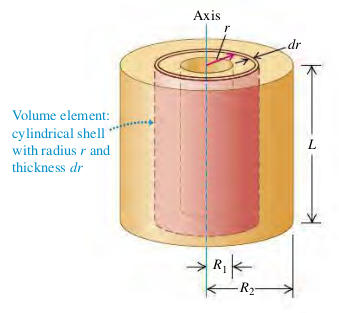0906 Moment of Inertia
I = ∫ r 2 d m \begin{aligned}
I = \int r^2 dm
\end{aligned}
I = ∫ r 2 d m
Examples
(9.10) Figure 9.23 shows a hollow cylinder of uniform mass density r with length L, inner radius R 1 R_1 R 1 R 2 R_2 R 2
Solution
I = ∫ r 2 d m = ∫ R 1 R 2 r 2 ρ ( 2 π r L d r ) = 2 π ρ L ∫ R 1 R 2 r 3 d r = 2 4 π ρ L ( R 2 4 − R 1 4 ) = 1 2 π ρ L ( R 2 2 − R 1 2 ) ( R 2 2 + R 1 2 ) (1) \begin{aligned}
I &= \int r^2 dm = \int_{R_1}^{R_2} r^2 \rho (2\pi r L dr)\\
&= 2\pi \rho L \int_{R_1}^{R_2} r^3 dr\\
&= \frac{2}{4} \pi \rho L(R_2^4 - R_1^4)\\
&= \frac{1}{2} \pi \rho L(R_2^2 - R_1^2)(R_2^2 + R_1^2) &\text{(1)}\\
\end{aligned}
I = ∫ r 2 d m = ∫ R 1 R 2 r 2 ρ ( 2 π r L d r ) = 2 π ρ L ∫ R 1 R 2 r 3 d r = 4 2 π ρ L ( R 2 4 − R 1 4 ) = 2 1 π ρ L ( R 2 2 − R 1 2 ) ( R 2 2 + R 1 2 ) (1)
The cylinder's volume is V = π L ( R 2 2 − R 1 2 ) V = \pi L (R_2^2 - R_1^2) V = π L ( R 2 2 − R 1 2 )
M = ρ V = π L ( R 2 2 − R 1 2 ) (2) \begin{aligned}
M &= \rho V = \pi L (R_2^2 - R_1^2) &\text{(2)}
\end{aligned}
M = ρ V = π L ( R 2 2 − R 1 2 ) (2)
Substituting Eq. (2) to Eq. (1), we see that
I = 1 2 M ( R 2 2 + R 1 2 ) \begin{aligned}
I &= \frac{1}{2} M(R_2^2 + R_1^2)
\end{aligned}
I = 2 1 M ( R 2 2 + R 1 2 )
If the cylinder is solid, with outer radius R 2 = R R_2 = R R 2 = R R 1 = 0 R_1 = 0 R 1 = 0
I = 1 2 M R 2 \begin{aligned}
I &= \frac{1}{2}MR^2
\end{aligned}
I = 2 1 M R 2
If the cylinder wall is very thin, we have R 1 ≈ R 2 = R R_1 \approx R_2 = R R 1 ≈ R 2 = R
I = M R 2 \begin{aligned}
I &= MR^2
\end{aligned}
I = M R 2
Exercises
(Quiz) Use Integration and d I = r 2 d m d I = r^2 dm d I = r 2 d m
Solution
I = ∫ r 2 d m = ∫ − x L − x ( r 2 M L ) d r = 1 1 2 M L 2 + M ( L 2 − x ) 2 \begin{aligned}
I &= \int r^2 dm\\
&= \int_{-x}^{L-x} (r^2 \frac{M}{L})dr\\
&= \frac{1}{12}ML^2 + M(\frac{L}{2} - x)^2
\end{aligned}
I = ∫ r 2 d m = ∫ − x L − x ( r 2 L M ) d r = 1 2 1 M L 2 + M ( 2 L − x ) 2
L = 1 m L = 1m L = 1 m x = 0 . 1 m x = 0.1m x = 0 . 1 m
I = 1 1 2 M + M ( 1 2 − 0 . 1 ) 2 = 0 . 2 4 3 M \begin{aligned}
I &= \frac{1}{12} M + M(\frac{1}{2} - 0.1)^2\\
&= 0.243M
\end{aligned}
I = 1 2 1 M + M ( 2 1 − 0 . 1 ) 2 = 0 . 2 4 3 M
